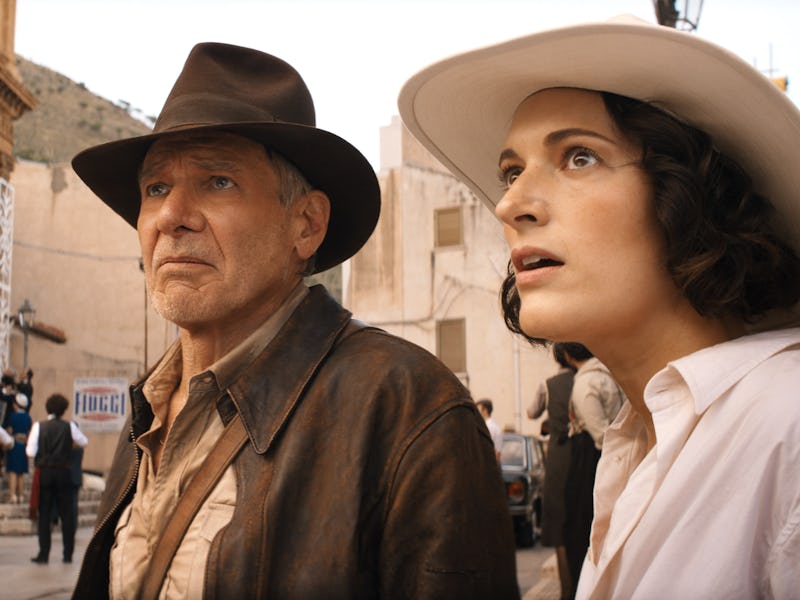Indiana Jones 5’s Wild Ending Makes Good on a 42-Year-Old Franchise “Rule”
James Mangold reveals why [SPOILERS] and the alternate ending he also considered.

“It's almost a rule of Indiana Jones movies that the power of the relic becomes the third act of the movie when it gets unleashed in whatever form it reveals itself,” James Mangold tells Inverse.
The director of Indiana Jones and the Dial of Destiny is being just vague enough that the above quote isn’t a spoiler, but if you’ve seen Indiana Jones 5, you know exactly what he’s talking about. The new movie features a wild third act that matches (and maybe even surpasses) the Harrison Ford adventures that came before it.
“I always find it interesting as I get reactions to the movies that people are kind of going, wow, you really took a big swing in the end. And I'm like, ‘Really!’” Mangold says with a grin. “Because opening a box and having 300 fang-filled ghosts emerge, blow up Nazi heads, melt their brains, but leave our heroes alone as the clouds open up and the contents of the box get sucked into the cumulonimbus cloud hovering above an island ... that's small? A 2000-year-old knight from the round table living in a cave, defying all rules of probability and longevity, waiting for them to face a magical challenge in a well? All of these things seem stupendous to me.”
In other words: Indiana Jones has always pushed the limits, and Dial of Destiny is no exception.
If you’ve read this far but haven't seen Indiana Jones 5, you may be wondering what the heck Mangold is talking about. To explain, we have to go deep into spoiler territory to reveal why Dial of Destiny’s jaw-dropping ending was the best and only option — and the one other ending the director considered.
Warning! Huge spoilers for Indiana Jones and the Dial of Destiny ahead.
Indiana Jones 5 ending explained
Harrison Ford searches for the tomb of Archimedes.
Like the Ark of the Covenant and the Holy Grail before it, the magic MacGuffin at the heart of Indiana Jones 5 is another ancient artifact: the Dial of Archimedes (aka the Antikythera mechanism). In the opening act of the movie, Indy steals the object from a Nazi scientist played by Mads Mikkelsen. Mads believes the dial, designed by ancient Greek mathematician Archimedes, holds the secret to time travel. (Unfortunately, he only found half of it.)
Two decades later, Mads resurfaces as a rocket scientist recruited by the USA. He sends his goons after Indy to reclaim the dial, sparking a globe-trotting Indiana Jones adventure. Eventually, the Nazis get the full dial (with Indy’s unwilling help, of course) and chart a course for the early 1940s. The villain’s plan is to murder Adolf Hitler (whom he blames for causing the Nazis to lose World War II) so he can change the course of history.
(Yes, you read that correctly, in Dial of Destiny, Indiana Jones’ ultimate goal is to save Hitler’s life.)
Mads Mikkelsen’s evil Nazi finds the first half of the dial.
Good luck for Hitler: Archimedes made a mistake (something about continental drift?) and they wind up in the year 200 B.C.E. in the midst of a Roman battle. The Nazis all get murdered by ancient weaponry, and Indy meets Archimedes. Our hero briefly considers staying in the past, but he’s dragged back to the present where he reunites with his one true love: Marion Ravenwood. The end.
But what does it mean? Here’s James Mangold again to explain.
Indiana Jones 5 ending, explained by director James Mangold
“The real answer you're looking for is: the theme of the movie was time,” Mangold tells me. “My Indy is a 70-year-old Indy, and so I wanted not just time in the sense of travel, but time in the sense of, I can't undo the mistakes of my past. I can't be the guy I was then because the world has changed around me. Time and all its facets that catch up with us as we get older.”
Mads Mikkelsen, Harrison Ford, James Mangold, and Phoebe Waller-Bridge at the premiere of Indiana Jones and the Dial of Destiny.
Indiana Jones 5’s alternate ending
If you’re wondering whether Mangold considered any other options before sending Indy to 200 B.C.E., the answer is yes. But just one.
“I would never make this choice without ruminating over lots of choices,” Mangold says. “The other interesting thing was that one of the things I thought about was even if we did travel in time, would Mads' theory be right and they’d land in Nazi Germany? And the last act of the movie would be Indie trying to foil Mads' plan? But the more I sketched that out in my mind, the more that became kind of just a spy movie at the end. I couldn't find a way to emotional resonance.”
A de-aged Harrison Ford in the opening scene of Dial of Destiny.
Sending Indiana Jones back to WW2, again, also would have left a major thread of Dial of Destiny unresolved.
“It occurred to me that we've been talking about three different time periods a lot in the movie: 1968, 1944, and 200 BC,” Mangold says. “So why don't we go there? Because that's the only one I've been hearing a lot about but I haven't seen.”
This also opened up the possibility of giving Indy a totally new experience that’s still in keeping with his character.
“The idea immediately moved me,” Mangold says. “Indy’s character would suddenly be faced with something he's only imagined all his life. The reality of something he's been only looking at through the keyhole of history and artifacts and is suddenly in it. And what a powerful moment that might be for Harrison himself to play.”
Indiana Jones and the Dial of Destiny is in theaters now.
This article was originally published on